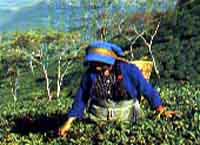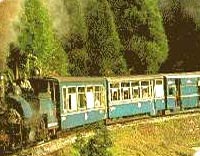|
Travelogues Toy Train to Darjeeling
|
|||||||||
One fine morning the ring of the telephone connected me to Mr.McNamara. I had lost touch with him since my six month stay in Paris way back in 1993. He was with the UNESCO Headquarters in Paris dealing with various World Heritage sites. We had met many times both socially and professionally. He was quite excited and informed me that UNESCO had received a proposal to place the toy train to Darjeeling among the World Heritage list and that UNESCO's reaction was positive. He said that it was only a matter of time before the final approval came through. He also told me that Discovery Channel had made a documentary of the Toy Train that was likely to be beamed to viewers world wide in August 1999. He felt, and correctly so, that being a native of Darjeeling, I would receive these tidings with great joy.
Suddenly, my memories flashed back six decades to the hills of Darjeeling where I spent my childhood. The toy train was then known as the Darjeeling Himalayan Railways or by its short form, the DHR. My family were the leading merchants of Darjeeling with a monopoly on supplies to the entire districts of Darjeeling and Jalpaiguri and, to a lesser extent, Calcutta. Darjeeling's elite were either the British ruling class of the time, who visited Darjeeling every summer, affluent Indians who maintained properties there like Maharajas and land-owning Zamindars - many of whom conveniently usurped the prefix of "His Highness" to elevate themselves to the ranks of Maharajas - or some well-known Barristers of the Calcutta High Court. |
More on West Bengal • Overview • Darjeeling
Travelogues
Impressions
Trekking | ||||||||
The General Manager of DHR, an Englishman named Cunningham approached my father through the ADC to the Governor of Bengal ,one Col. Johnston. The introduction of trucks to carry goods from Siliguri Junction to Darjeeling, and on the return journey carry tea chests and timber, would be disastrous as the DHR would have had to wind up as a result. Cunningham therefore implored my father not to introduce trucks but to continue using the DHR. My father acquiesced. Later, Cunningham personally met my father to deliver him a Complimentary First Class Railway Pass with the provison to take 2 personal servants in the III class and 2 maunds of luggage, as a token of DHR's appreciation. However, my father hardly used the Railways pass as it was more convenient and time saving to use a car.
My grand father would love to narrate the story of how the toy train had to wait for hours on the narrow guage track in the Sukna jungle because a tigress with grown cubs was lying on the tracks. Sukna jungle at that time was densely forested and was the habitat of several tigers and other large animals. Alas, none of these majestic beasts have survived the relentless expansion of human habitation. Wildlife has ceased to exist in the Darjeeling hills!
Life in the hills was simple and men were of sterling quality - loyal to the organisations they served. DHR's servants were distinctly above the ordinary babu class of the local Kutchery and other public servants. One such person who comes to mind was a Bengali gentleman. Employed in the DHR as a guard, he was distinct from his other colleagues who were Anglo Indians - dressed in immaculate white tunics in summer with a broad leather band across their shoulders with whistles elegantly placed between, and their peak caps and the shining metal emblem of DHR. Ghose Babu, as he was called, was one of those loyal servants of the company, very conscientious in performing his work beyond the call of duty.
He used to be deputed only in the local trains which had a total run of about 20 miles from Kurseong to Darjeeling, while the prestigious Mail trains had mostly Anglo-Indian guards. Ghose Babu had rather dark features and looked almost like a scarecrow in his thick woolen navy blue galaband with it's DHR metal emblem. He was nicknamed "Sugay" (parrots' beak) because he had a sharp nose with thin skin like that of a parrot's beak. Whenever he was on duty a number of ticketless travellers would be in his bag by the end of the day. He would hop from compartment to compartment in the moving train checking tickets and booking those without tickets. The Toy Trains's speed was such that one could disembark from a moving train at full steam, run faster than the train and hop on again in a different compartment. This would enable agile young boys without tickets to play hide and seek with Ghose Babu "Sugay".
One of Ghose Babu's Anglo Indian colleagues was one Mr. Smith. He was a replica of the comedian Hardy but was very agile and sportsman like. He was an expert kite flyer and raised excellent specimens of fighting cocks. He was straight out of Somerset Muugham's short stories. He had come to India with his parents when he was an infant. Among the engine drivers was a burly Anglo Chinese who was one of the leading drivers of DHR and was always assigned to the Mail train. When McNamara informed me that the Toy Train of Darjeeling was to be inscribed on the World Heritage List of UNESCO, it was these dedicated and loyal servants of the DHR whom I spontaneously remembered in tribute - - for it was they who made it possible for the toy train to attain its present status.
|
|||||||||
Editor: Romola Butalia (c) India Travelogue. All rights reserved. |
|||||||||


 DHR was one of the most romantic railways winding its way up the hills. It carried soldiers, planters, holiday-makers escaping the heat and dust of the plains of Bengal and collieries of the Chota Nagpur plateau, and European parents visiting their boarding-school children in Darjeeling. Among the famous schools were the Queen's Hill Girls School that was unfortunately razed in a fire that killed several students. St. Michael's School for girls and St.Paul's School for boys were Anglican Church Schools catering primarily to those belonging to Church of England who would not have wanted to send their children to the excellent Catholic schools like St. Joseph's (North Point), run by Jesuits and Loreto Convent by Irish nuns. The Queen's Hill School which was so tragically destroyed by fire was later shifted to the present day Mount Hermon School.
DHR was one of the most romantic railways winding its way up the hills. It carried soldiers, planters, holiday-makers escaping the heat and dust of the plains of Bengal and collieries of the Chota Nagpur plateau, and European parents visiting their boarding-school children in Darjeeling. Among the famous schools were the Queen's Hill Girls School that was unfortunately razed in a fire that killed several students. St. Michael's School for girls and St.Paul's School for boys were Anglican Church Schools catering primarily to those belonging to Church of England who would not have wanted to send their children to the excellent Catholic schools like St. Joseph's (North Point), run by Jesuits and Loreto Convent by Irish nuns. The Queen's Hill School which was so tragically destroyed by fire was later shifted to the present day Mount Hermon School.
 And so the antics of running alongside the train and jumping on and off at different points was a regular feature with "Sugay" waiting in ambush at some corner of the train. The toughies from Ghoom were his main targets and there was always a lively chase between Sugay and the Ghoom boys. The town would buzz with reports that the tough boys of Ghoom had roughed him up in some corner of the train. Undaunted, Sugay would be on duty the next day with stitches and a plaster on his nose.
And so the antics of running alongside the train and jumping on and off at different points was a regular feature with "Sugay" waiting in ambush at some corner of the train. The toughies from Ghoom were his main targets and there was always a lively chase between Sugay and the Ghoom boys. The town would buzz with reports that the tough boys of Ghoom had roughed him up in some corner of the train. Undaunted, Sugay would be on duty the next day with stitches and a plaster on his nose.